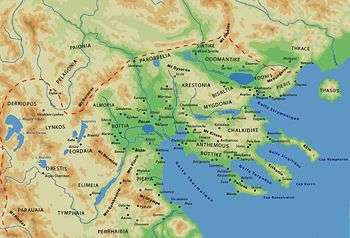Pelagonia


Pelagonia (Greek: Πελαγονíα, Macedonian: Пелагонија, Pelagonija) is a geographical region of Macedonia.
History

In antiquity, it was roughly bounded by Paionia to the north and east, Lynkestis and Almopia to the south and Illyria to the west. Ancient Pelagonia is located in the south-western regions of the modern Republic of Macedonia.[1] The region was annexed to the Macedonian kingdom during the 4th century BC and became one of its administrative provinces. In medieval times, when the names of Lynkestis and Orestis had become obsolete, Pelagonia acquired a broader meaning. This is why the Battle of Pelagonia (1259) between Byzantines and Latins includes also the current Kastoria regional unit and ancient Orestis.
Many Mycenaean objects have been found in the area, such as the double axe, later found in Mycenae. Mycenaean finds are exhibited in the Museum of Bitola. The region was inhabited by the Pelagones, an Epirote Molossian tribe according to Strabo,[2] who calls Pelagonia Tripolitis[3] albeit he names only one city of the supposed three; Azorus. Only two Pelagonians are known to us: the one, the mythological Pelagon, the eponymous of the region, was son of the river-god Axius (modern Vardar) and father of the Paeonian Asteropaeus in the Iliad. The second one is Menelaus of Pelagonia (ca. 360 BC) who, according to Bosworth, fled his kingdom when it was annexed by Philip II, finding refuge and citizenship in Athens.[4]
Today, Pelagonia is a plain shared between the Republic of Macedonia and the district of Macedonia in Greece. It incorporates the southern cities of Bitola and Prilep in the Republic of Macedonia and the northwestern city of Florina in Greece; it is also the location of a key border crossing between the two countries Medžitlija-Niki.
See also
References
- ↑ PHI Greek Inscriptions - Regions: Northern Greece (IG X): Macedonia: Pelagonia.
- ↑ John Boardman and N. G. L. Hammond. The Cambridge Ancient History Volume 3, Part 3: The Expansion of the Greek World, Eighth to Sixth Centuries BC. Cambridge: Cambridge University Press, 1982, p. 284.
- ↑ Strabo. Geographica, 7.327.
- ↑ Bosworth, A.B. "Philip II and Upper Macedonia", CQ, 21 (1971).
External links
- Pelagonian margins in central Evia island (Greece)
- The oldest rocks of Greece: first evidence for a Precambrian terrane within the Pelagonian Zone
- The ancient city of Pelagonia in the historical and epigraphic monuments
Coordinates: 41°00′00″N 21°21′00″E / 41.0000°N 21.3500°E